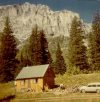-

Romancing the River 3: A River to Love but Sometimes Really Dislike
‘Man, during all his wanderings in the struggle for subsistence, has universally found [the rivers] his friends and allies…. ‘By contrast, it is all the more remarkable to meet with one great river which is none of these helpful things, but which is a veritable dragon, defiant, fierce, opposing utility, refusing absolutely to be bridled…
-

Romancing the River 2: Manifest Destiny meets the Great American Desert
In the last post, I unabashedly advanced the hypothesis that most of what happened in the Colorado River region, over the past century and a half, might have been the consequence of a cultural microbe that spread through the system from the ‘fabled Hassayampa,’ an intermittent Colorado River tributary in Arizona: ‘of whose waters,’ according…
-

Romancing the River 1: The Romance of Science
As we’ve seen over the past several posts here, humans have inhabited the region of what we now know as the Colorado River, Rio Colorado, River of Color, for ten or twelve millennia – in small wandering bands most of that time, hunters and foragers; then as their numbers grew in the mellow Holocene, they…
-

Working with the Counterrevolutionaries: The Sawmill
Back (almost) to the present, in this meandering journey over the life and times of the Colorado River region. This is a followup on the last post, which posed the perspective that the westward expansion of Western Civilization across North America was a territorial contention between two big cultural paradigms. Dominating the contention was the…
-

Westward the Curse of Empire: Two More American Cultures come to the River
The third and final human invasion of the Colorado River region in the Holocene came from the east, from England and Europe and their Atlantic Coast colonies. The native peoples of the first invasion (10-11 thousand years ago from Asia via that Bering land-bridge) had risen up against the Spaniards of the second invasion, from…
-

The Search for the Seven Cities of Gold
In the last post here, I cobbled together an ‘Anthropocene variant’ on the rise and fall of civilizations, suggesting that the rise of advanced cultures was less a triumph of creative upward striving, and more a matter of beleaguered people engaging in creative problem-solving to deal with the challenge of populations outgrowing their systems for…
-

A Story about Early Times in the Colorado River Region and the Traumas of Success
Recent posts here have mostly been about the Colorado River – its chaotic origins, the source of its waters, and the things that happen to its waters immediately after falling onto the Southern Rockies, the geology it has carved, the biota it has nurtured. It should be no surprise, given that geography of climatic and…
-

Wintering up the East River
Going up to the East River valley this week, a tributary to the Gunnison and eventually the Colorado River. But no lecture today. I realize I’ve been pontificating a little in these postings. My Gunnison friend Mike calls me ‘Perfesser’ – which harks up memories from fifty years ago of my first editor, also named…
-

The Water: Where does it all go?
The previous post here ended with the observation, from the 2020 Western Water Assessment Colorado River science study, that around 170 million acre-feet of water fall on the Colorado River Basin – but only 14-17 million acre-feet end up in the actual river. Where does the other 90 percent go? And a corollary question: for…
-

Where does our water come from? And what are we doing to it in the Anthropocene?
For anyone seeing our planet for the first time from a satellite’s perspective, worries about water might be the last thing to cross their mind. Had we first seen the planet that way; we would probably have named it ‘Water’ rather than ‘Earth.’ Looking at its clouds and ice sheets as well as its expanses…
-
A Quick Natural History of the Colorado River
In the last posting, I discussed the great volume of written and visual material that has emerged in recent decades about the Colorado River – First River of the Anthropocene – almost all of it increasingly critical of what we have done with and to the river. It is certainly true that a lot of…
-
The Colorado – First River of the Anthropocene
I said in the first post here that I’ll be focusing on ‘learning to live with the Anthropocene’ – a work-in-progress for everyone who will even acknowledge the existence of the Anthropocene. To refresh your mind on it – the Anthropocene is a new epoch in the evolution of the planet in which the human…
-

Sibley’s Rivers? What, Why and – Why Not?
The first thing I want to say about ‘Sibley’s Rivers’ is to not be misled by the name; it’s not going to be all about rivers – although because the West will be the locus of focus, the rivers that run through it (or don’t) will be frequent topics. Especially the Colorado River, which is…